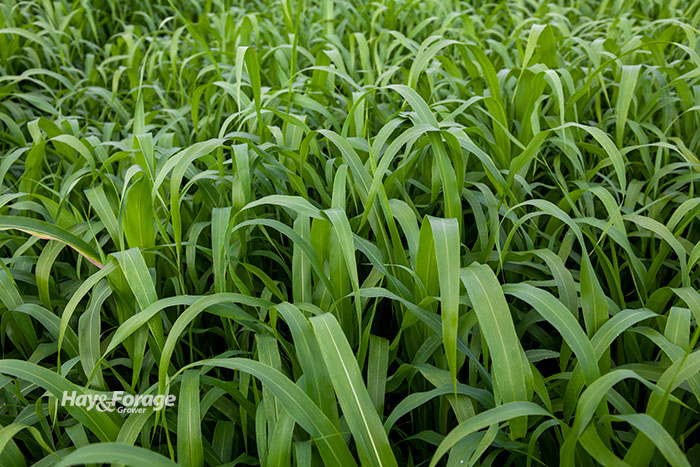
Sorghum and its many variations now appear in fields across the U.S. with virtually no latitude or longitude limitations when hybrids are properly selected. Their ability to tolerate drought, generate substantial biomass, and produce high-quality forage makes sorghum species a valuable option in the forage toolbox.
In a recent Forage Forum webinar offered by Purdue University Extension, postdoctoral researcher Shelby Gruss discussed sorghum’s flexibility as a silage, hay, and grazing crop.
For forage producers, the most widely utilized sorghum types include the high-yielding, one-cut forage sorghum hybrids and the multi-cut sudangrass and sorghum-sudangrass hybrids.
Forage sorghums are almost always harvested as silage, whereas sorghum-sudangrass and sudangrass can be utilized as silage, greenchop, hay, or for grazing. In much of the U.S., making dry hay from sorghum species is challenging because the stems are difficult to dry down.
Gruss noted that any of the harvest method options shouldn’t occur until plants have reached at least 18 to 24 inches tall to avoid prussic acid concerns. She also said that greenchopped sorghum needs to be fed the same day to avoid nitrite accumulation in the feed.
When planning to incorporate sorghum species into a crop rotation, it’s critical to wait until soil temperatures reach at least 60°F before planting. “Sorghum thrives in high temperatures and will continue growing in temperatures up to 100°F, whereas corn will stop growing at about 85°F,” Gruss said. “Sorghum also requires less fertilizer and water compared to corn.”
It starts with dhurrin
“Although sorghums have many benefits, there are also some concerns with the crop,” Gruss asserted. “These are prussic acid poisoning and high nitrates, although the latter can be a problem in many other types of forage crops as well.”
The researcher noted that a compound called dhurrin is the precursor to the formation of prussic acid (hydrocyanic acid) and is most prevalent in young plants or tillers and plant leaf tissues that are stressed in some way, such as frost or drought. Like nitrates, dhurrin levels can also rise when a crop is overfertilized with nitrogen.
To avoid problems with prussic acid, Gruss suggested not harvesting or grazing plants less than 2-feet tall, not harvesting plants under drought stress, and waiting at least a week before harvesting frosted plants. She also noted that producers can choose sorghum hybrids that have been selected for low dhurrin content. For sorghums harvested as silage, fermentation will help reduce prussic acid levels.
Traits abound
One of the producer benefits of sorghum species is that there is a plethora of available traits to fit an operation’s needs and cropping plans. Those currently available are listed below, and some hybrids possess more than one of these traits:
- Sugarcane aphid tolerance
- Brown midrib
- Photoperiod sensitivity
- Dry stalk
- High leaf-to-stem ratio
- Brachytic dwarf
- Herbicide resistance (non-transgenic)
Coming soon
Gruss pointed out that dhurrin-free or prussic acid-free hybrids will soon be on the market; these originated from some of her research at Purdue. The dhurrin-free hybrids are expected to be available in the next two to three years and have proven to be highly preferred by grazing livestock.
Also, during the course of the Purdue research, Gruss said they found that dhurrin content or prussic acid poisoning potential was not reduced during the wilting period of sorghum forage after being cut. This means that prussic acid poisoning is still a risk for dry hay. This finding contrasted with previous reports.
In closing, Gruss said it is important for producers to consider their cropping and feeding goals to determine what traits will fit best on their farms. For example, a photoperiod sensitive hybrid may be a problem for silage harvest because it never goes reproductive in Northern latitudes. As a result, it stays wet and requires a freeze before it will dry down. On the flip side, these types may be beneficial in a grazing situation.
To view Gruss’ presentation in its entirety, click here.

